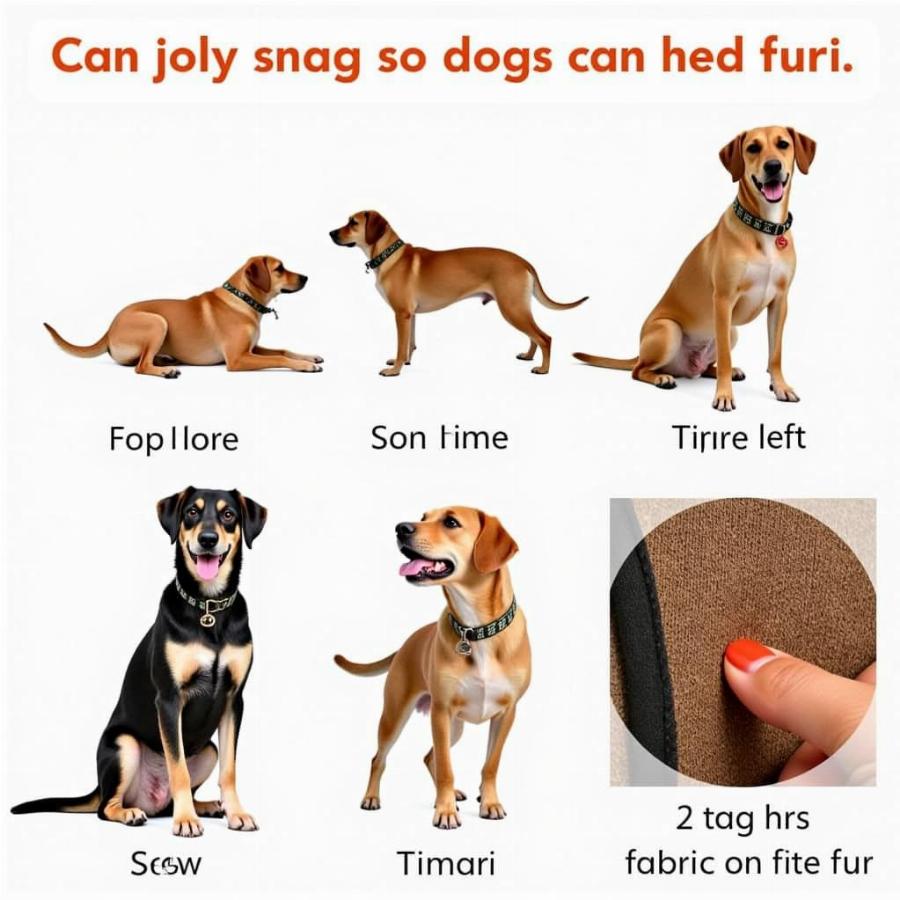Bad dog tags can be more than just an inconvenience; they can be a real safety hazard for your furry friend. A broken tag can leave your dog lost and unidentified, while a poorly designed tag can be noisy, uncomfortable, or even get caught and cause injury. This article will delve into the common problems associated with bad dog tags and guide you in choosing the best and safest identification for your canine companion.
Identifying “Bad” Dog Tags: What to Avoid
What exactly constitutes a “bad” dog tag? Several factors can contribute to a tag’s inadequacy. These include flimsy materials that break easily, shallow engraving that fades quickly, noisy tags that jingle incessantly, and tags with sharp edges that can irritate your dog’s skin. Overly large or heavy tags can also be uncomfortable, especially for smaller breeds.
Material Matters: Durability is Key
Choosing a durable material is paramount. Avoid cheap aluminum or plastic tags, as these are prone to breaking and the engraving can wear off rapidly. Opt for stainless steel or durable, non-corrosive metals. These materials can withstand daily wear and tear, ensuring your dog’s identification remains intact.
Silent Tags for Sensitive Ears (and Owners!)
The constant jingling of tags can be irritating for both you and your dog. Consider silent tags, which are designed to minimize noise. These are particularly beneficial for dogs who are easily startled or anxious.
“Choosing the right material for your dog’s tag is essential. Stainless steel is a great option as it’s durable and hypoallergenic,” says Dr. Emily Carter, a veterinary specialist in canine behavior and welfare.
Choosing the Best Dog Tags: A Comprehensive Guide
Selecting the right dog tag involves considering several factors, including material, size, shape, and attachment method.
Sizing Up the Situation: Finding the Right Fit
The tag’s size should be proportional to your dog’s size. A large, heavy tag on a small dog can be cumbersome and uncomfortable. Conversely, a tiny tag on a large dog can be easily lost.
Shape and Attachment: Prioritizing Safety and Comfort
Rounded tags with smooth edges are less likely to catch on things or irritate your dog’s skin. Consider using split rings or specialized tag silencers to further reduce noise and prevent snagging.
 Chọn kích thước nhãn diện cho chó
Chọn kích thước nhãn diện cho chó
Engraving: Making Information Last
Deep, clear engraving is essential for readability. Ensure the information is accurate and includes your dog’s name, your phone number, and any essential medical information. Microchipping is an important additional safety measure, but a visible tag provides immediate identification.
“Always double-check the engraved information for accuracy. In an emergency, every second counts,” advises Dr. Carter.
Beyond the Basics: Personalized and Specialized Tags
Beyond the standard information, you can personalize your dog’s tag with their address, your email, or even a QR code linked to their online profile. Specialized tags for service dogs, therapy dogs, or dogs with specific medical conditions are also available.
Maintaining Your Dog’s Tags: Tips for Longevity
Regularly inspect your dog’s tags for wear and tear. Replace them if the engraving becomes illegible or the material shows signs of damage. This simple step can significantly improve your dog’s safety.
Conclusion: Investing in Your Dog’s Safety
Bad dog tags can jeopardize your dog’s safety. By understanding the characteristics of poorly designed tags and following the guidelines outlined in this article, you can choose the best and safest identification for your furry companion. A good quality, well-maintained dog tag provides peace of mind and increases the chances of a happy reunion should your dog ever become lost.
FAQ: Common Questions About Dog Tags
- What information should be engraved on a dog tag? Your dog’s name, your phone number, and any essential medical information.
- What material is best for dog tags? Stainless steel is a durable and hypoallergenic option.
- How can I reduce the jingling noise of dog tags? Use silent tags or tag silencers.
- How often should I replace my dog’s tags? Replace them if the engraving becomes illegible or the material shows signs of damage.
- Are dog tags a substitute for microchipping? No, microchipping is an important additional safety measure.
More Helpful Resources
Beaut Dogs is your trusted source for all things dog-related, providing expert advice and information to help you provide the best possible care for your canine companion. From breed information to health and training tips, we’re here to support you every step of the way. When you need assistance, please contact us at Email: [email protected] for detailed and accurate answers from Beaut Dogs. Visit https://beautdogs.com today to learn more!